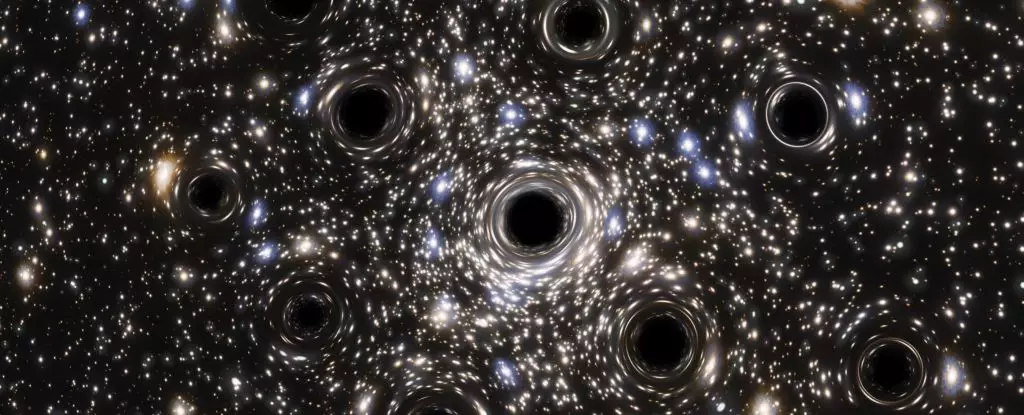The universe continually surprises us with its unfathomable complexities, and recent revelations about Omega Centauri, the largest globular cluster in the Milky Way, have escalated intrigue surrounding this astronomical body. Located over 17,000 light-years from Earth, Omega Centauri is home to approximately 10 million stars, constituting a fascinating mix of cosmological history and astrophysical phenomena. The latest findings suggest the presence of numerous stellar-mass black holes within this cluster, reshaping our understanding of black hole formation and evolution.
Previously, research had proposed that a single black hole, significantly more massive than the Sun, resided within Omega Centauri. This notion aligned with the theories surrounding intermediate-mass black holes (IMBHs) — theorized to exist but long elusive in the wider cosmos. Dr. Andrés Bañares Hernández, an astrophysicist at the Institute of Astrophysics of the Canary Islands, elucidates that highlighting the presence of multiple stellar-mass black holes might resolve ongoing debates and expand our comprehension of black hole astrophysics.
Intermediate-mass black holes are conceptualized as having masses ranging from hundreds to thousands of solar masses, situated in a mysterious middle ground between stellar-mass black holes—formed from collapsing stars—and supermassive black holes that anchor galaxies at their cores. Intriguingly, while stellar-mass and supermassive black holes are widely documented, intermediate-mass black holes remain largely theoretical. Their existence could illuminate vital connections in our understanding of black hole evolution.
Omega Centauri is believed to represent the remnant core of a dwarf galaxy known as the Gaia Sausage, suggesting its structure and composition may resemble that of smaller galaxies. Such dwarf galaxies are not only repositories of stars but also potential candidates for housing IMBHs. Evidence gathered from star patterns and movements within Omega Centauri hints at the gravitational influences exerted by these hidden masses and anchors research focusing on black hole demographics.
In a bid to explore the structure of Omega Centauri more intricately, Dr. Bañares Hernández and his team employed a novel approach by incorporating data from pulsars—rapidly rotating neutron stars that emit beams of energy. The timing and behavior of pulsar emissions can yield exceptionally precise measurements regarding motion and acceleration of surrounding astronomical bodies. Using this data, the researchers reevaluated the dynamics of the stars within the cluster, with emphasis on their interactions with conceivable hidden black holes.
The analysis revealed that rather than a solitary massive black hole being responsible for the star motions observed, a multitude of smaller, stellar-mass black holes might better explain these dynamics. This finding casts a new light on the previously favored IMBH hypothesis, opening avenues for considering that both stellar-mass black holes and intermediate-mass black holes could coexist within Omega Centauri. Such coexistence could be attributed to the gravitational interactions where stellar-mass black holes might exist under the gravitational umbrella of a more considerable, yet still hypothetical, IMBH.
The potential insights gained from these recent investigations could possess broader implications for our understanding of cosmic hierarchies. If stellar-mass black holes can form effective clusters and potentially merge under the influence of a larger black hole, it would offer a compelling narrative explaining the growth and evolution of larger black holes. This reveals a possible evolutionary path whereby IMBHs form through the merging of stellar-mass black holes, reshaping the landscape of our black hole theories.
As researchers continue to unravel the mysteries surrounding Omega Centauri, the implications extend beyond this single cluster. The study of black holes, their formation, and role in the evolution of galaxies remains foundational to modern astrophysics. New methodologies that integrate varied astrophysical observations and models may lead to an accelerated understanding of how black holes interact and grow over cosmic time.
Despite the challenges presented by the elusive nature of black holes, the pursuit of discovering IMBHs remains robust. As meticulous studies peel back the layers of these celestial phenomena, we stand on the brink of potentially groundbreaking discoveries. Each piece of evidence converging from sources such as Omega Centauri not only enriches our comprehension of stellar constituents but also beckons further inquiries into the infinite universe around us. The universe continues to hold secrets, and the journey of exploring black holes is just as vital to our understanding of existence itself.


Leave a Reply